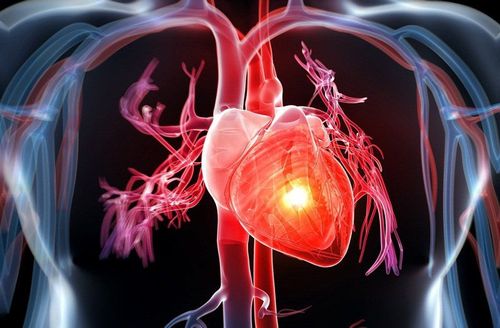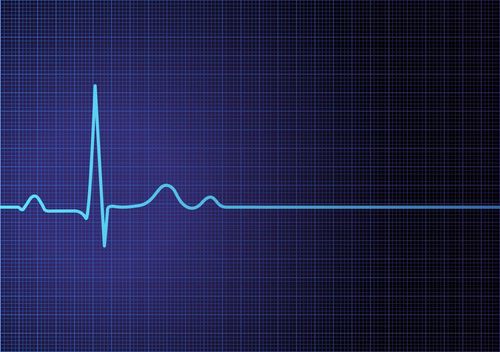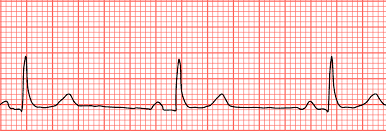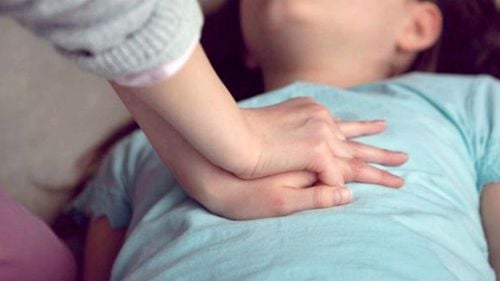This is an automatically translated article.
The article was professionally consulted by Doctor of Pediatrics - Neonatology - Vinmec Nha Trang International General Hospital.Cardiopulmonary resuscitation should be performed as soon as the patient's cardiac arrest or respiratory arrest is detected. Parents and those who directly care for children need to know how to give CPR for infants and young children, because there are many causes that can cause a child to have a cardiac arrest, stop breathing that we do not anticipate. before can.
1. What is CPR?
Cardiopulmonary resuscitation (CPR) is a useful first aid technique in an emergency for someone experiencing cardiac arrest or breathing. Cardiopulmonary resuscitation involves chest compressions and artificial ventilation to restore oxygen-rich blood to the patient's brain, thereby preserving brain function until further emergency measures are taken.In children, there are many causes of cardiac arrest, respiratory arrest such as trauma or some pathology,... Cardiopulmonary resuscitation techniques need to be started as soon as possible so that the child's ability to recover is good. than. However, this technique should only be performed when it is determined that the child is not breathing or has inadequate blood flow.
Time is an important factor when giving first aid to a child with cardiac arrest or respiratory arrest. Usually, brain damage will begin to appear after 4 minutes without oxygen and lead to death within 4-6 minutes afterwards.
The main causes of cardiac arrest and respiratory arrest in children are:
Children with airway obstruction Children asphyxiated (drowning). Children get electric shock. A child with massive bleeding A child with a head injury or severe trauma. Children with lung disease. Children are poisoned. Child is suffocated. Manifestations of cardiac arrest, respiratory arrest:
The child is not breathing The pulse is not checked. Child unconscious.
2. Cardiopulmonary resuscitation procedure for infants and young children
2.1. Check before performing CPR Before starting CPR for infants and young children, you need to check the following factors:Check that the surroundings are safe for you and young? Check if the child is conscious? If the child is unconscious, tap or shake the child's shoulder and ask loudly, "Are you okay?" or “Are you okay?”. Quickly observe the child for injuries, bleeding, or other medical problems. Place your ear near the child's mouth and nose, see if there is breath on your cheek? Check to see if the baby's chest is moving? When you identify a child in cardiac arrest, stop breathing, you should immediately do the following:
If you are alone with a child who is unresponsive and stops breathing, perform resuscitation CPR for the child within 2 minutes before calling 911. If someone else is there, shout for him or her to call 911 and then ask that person to locate a defibrillator (AED) immediately, while you begin CPR. As soon as a defibrillator is available, administer a shock according to the device's instructions, then begin CPR. 2.2. Cardiopulmonary resuscitation for young children The procedure for performing CPR for children from 1 year of age to puberty is basically the same as for adults. The American Heart Association recommends the following for performing CPR in children.

Thời gian là yếu tố quan trọng trong quá trình hồi sức tim phổi cho trẻ em
Place the baby on his or her back on a firm surface. Kneel beside the baby's neck and shoulders Use two hands, or only one if the child is very young, to perform chest compressions. Press straight down (compress/compress) your chest about 2 inches (about 5cm). If the child is a teenager, press straight down to the chest, the chest concave at least 2 inches (about 5cm) but not more than 2.4 inches (about 6cm). Continue pushing hard at a frequency of 100 to 120 compressions per minute. If you are not trained in CPR, continue chest compressions until the baby shows signs of movement or until paramedics arrive. If you have been trained in CPR, continue to open the airway and give CPR. 2.2.2. Open the airway If you have been trained in CPR and you have performed 30 chest compressions, open the child's airway by tilting the head up, lifting the baby's chin.
Place your palm on the child's forehead and gently tilt the child's head back. Then, gently lift the chin forward with your other hand to open the baby's airway. 2.2.3. CPR After 30 chest compressions, perform artificial breathing twice. Steps for artificial breathing for children are as follows:
Once the airway is open, you need to close the child's nostrils to breathe through the mouth and cover the child's mouth. Prepare to give two breaths. The first breath of air lasts a second, then you need to watch to see if the chest is inflated. If the chest is inflated, give a second blow. If the chest does not rise, repeat the head-up, chin-lift and then take a second breath. Be careful not to blow too much or blow too hard. After two artificial breaths, immediately begin the next cycle of chest compressions and artificial respiration. If two people perform CPR, give 15 chest compressions followed by two breaths. As soon as a defibrillator (AED) is available, apply and follow instructions. Use baby pads if available. If a child pad is not available, use an adult pad. Administer one electric shock, then continue CPR for two more minutes before administering a second shock. If you are not trained to use a defibrillator, call 911 or other medical personnel for instructions on its use. You need to continue performing CPR until the child moves or someone comes to help.
2.3. Cardiopulmonary resuscitation for infants 4 weeks of age and older Most infant cardiac arrests occur due to lack of oxygen such as drowning or suffocation. If you know your baby has an airway obstruction, administer first aid as if you were choking. If you do not know why the baby is not breathing, perform CPR.
To start CPR, check the situation carefully. Stroking your baby and watching for reactions, such as movements, but absolutely do not shake the baby. If the baby is unresponsive, follow CPR.
2.3.1. Chest compressions: restore blood circulation Steps to restore blood circulation to your baby are the following:
Place the baby on his or her back on a firm, flat surface, such as a table, or the floor can be used. house or ground. Visualize a line across your baby's nipples, placing two fingers of one hand just below this line, in the center of the chest (above the breastbone). Gently press the baby's chest down about 1.5 inches (about 4cm). Count out loud when you press to a fairly fast rhythm, you should press at a rate of 100 to 120 times per minute. 2.3.2. Open the airway After 30 chest compressions, gently tilt the baby's head back by lifting the baby's chin with one hand and pushing the baby's forehead down with the other hand.
2.3.3. CPR for the baby Cover the baby's mouth and nose with your mouth. Prepare to give two breaths. Use the force of your cheeks to create a gentle flow of air (instead of taking a deep breath from the lungs) to slowly breathe into the child's mouth one at a time, about a second for such a breath. You need to pay attention to see if the baby's chest is bulging. If yes, blow a second time. If the chest does not rise, you need to repeat the movement of the head up, chin lift, and then blow a second time. If the baby's chest still doesn't rise, continue chest compressions. Give two breaths after every 30 chest compressions. If two people are performing CPR, give two rescue breaths after every 15 chest compressions. Perform CPR for about 2 minutes before calling 911, unless someone else is available to make the call while you care for the baby. You need to continue CPR until you have signs of life or until paramedics arrive.

Các kỹ thuật hồi sức tim phổi cho trẻ từ 1 tuổi trở lên gần giống với các kỹ thuật thực hiện với người lớn
3. How can you learn CPR for infants and young children?
The best way you can learn how to perform CPR for infants and young children is by taking a class taught by a certified instructor. Hospitals and community centers offer cardiopulmonary resuscitation classes. You can go online to learn about cardiopulmonary resuscitation classes.The instructor will use a model the size of a baby to demonstrate how to perform the technique from tilting the head back to chest compressions, rescue breaths, and even back blows if the child is injured. suffocation.
Taking an in-person class is better than self-studying from a book or website, although these materials are very helpful in helping you gain knowledge about CPR.
Practicing CPR step-by-step with an experienced instructor will help you learn the correct technique and quickly remember what you've learned. Therefore, you will feel more prepared in case of an emergency than if you have just read about them and have never practiced.
4. What do you learn in a CPR class?
By taking a CPR class, you will learn the following useful things:You will learn techniques for handling life-threatening emergencies. For example, if a child is choking or unable to move or has stopped breathing due to a fall or suffocation. The techniques are different for babies and older children, so it is important that you learn both techniques. You will learn accident prevention and child protection measures. Learn how to prevent, recognize, and respond to cardiovascular and respiratory emergencies. Learn to use an automated external defibrillator (AED). Learn how to treat wounds and burns. Learn to care for sudden illnesses in infants and children under 12 years of age. CPR courses usually only last about 2 - 5 hours, so it won't take too long, but what you get is extremely valuable, it can help you save your baby's life. you or someone.
If you cannot take a CPR course, you can learn these through other formats, including:
An online CPR course for adults, children and infants line. A book and DVD on emergency preparedness. You can find resources on how to prevent, recognize and treat cardiac, respiratory and first aid emergencies, and what emergency supplies to have. Watch instructional videos on CPR for infants and older children. CPR is an important first aid technique, and everyone should be trained in it, especially parents and those who directly care for young children. Taking cardiopulmonary resuscitation classes is the best way to grasp and perform this technique. In addition, you can search for books, online courses, and video tutorials online to equip yourself with these important knowledge.

Hãy thử tham gia một lớp học về hồi sức tim phổi cho trẻ em
If you have a need for consultation and examination at Vinmec Hospitals under the nationwide health system, please book an appointment on the website for service.
Please dial HOTLINE for more information or register for an appointment HERE. Download MyVinmec app to make appointments faster and to manage your bookings easily.
Reference sources: babycenter.com, webmd.com, mayoclinic.org












